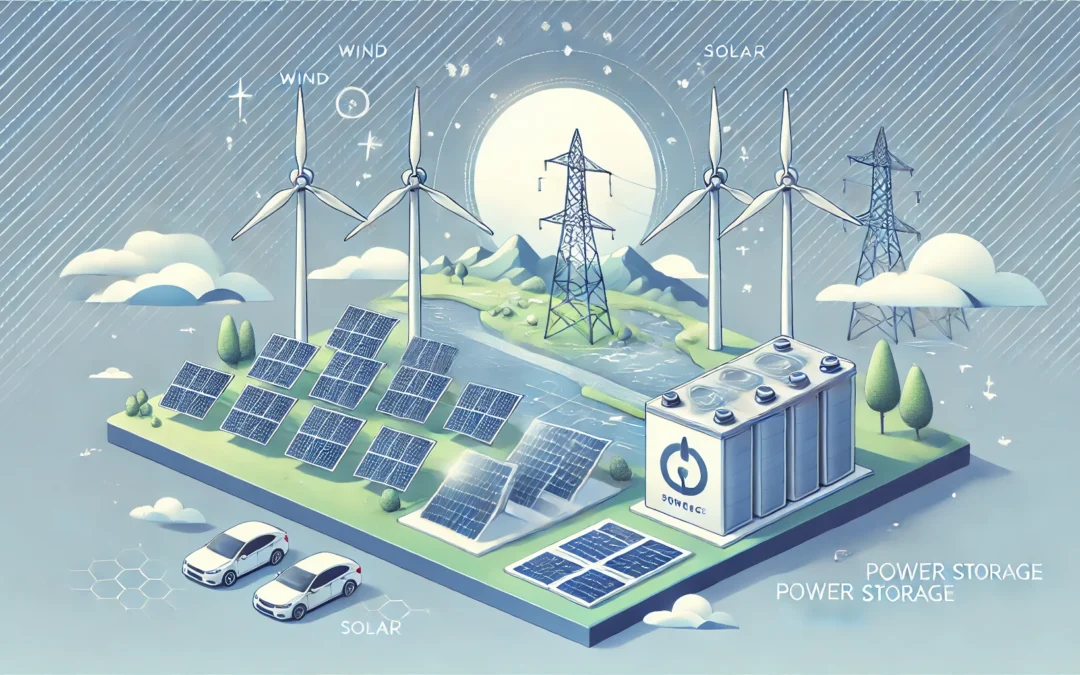Hybrid energy systems that integrate wind, solar, and energy storage represent a significant advancement in the pursuit of reliable, sustainable, and cost-effective renewable energy solutions. These systems combine the strengths of multiple renewable sources, ensuring a more consistent power supply, especially in areas with variable weather conditions. Here’s an in-depth look at how these hybrid systems work and their advantages.
1. What is a Hybrid Energy System?
A hybrid solar energy solution combines two or more energy generation sources, Hybrid Energy Systems with solar ,Wind & batteries to create a stable and reliable power supply. The system maximizes renewable energy generation, reduces reliance on fossil fuels, and can operate either on-grid or off-grid.
Key Components of a Hybrid System:
- Wind Turbines: Capture kinetic energy from wind and convert it into electricity. Wind energy is typically more available at night or during periods of cloudy weather.
- Solar Panels: Photovoltaic (PV) panels generate electricity from sunlight during the day. Solar energy is especially productive during sunny periods.
- Energy Storage (Batteries): Stores excess energy produced by wind and solar systems for use during periods when generation is low (e.g., night, cloudy days, or calm wind conditions).
- Control System: A smart management system that monitors energy production and consumption, switching between sources as needed and ensuring that stored energy is used when necessary.
2. Benefits of a Hybrid Energy System (Wind + Solar + Storage)
A. Complementarity of Wind and Solar Power
- Balancing Intermittency: One of the major challenges of wind and solar energy is their intermittent nature—solar power is only available during daylight hours, and wind power is not constant. However, wind and solar energy sources often complement each other. Wind energy tends to be stronger at night or during cloudy weather when solar power is not available. By combining both sources, the hybrid system can generate power more consistently.
- Maximizing Resource Use: Using both wind and solar maximizes the use of available natural resources, ensuring that renewable energy is produced throughout the day and night.
B. Energy Storage Increases Reliability
- Energy Storage Smoothing: Batteries store excess energy produced during periods of high wind or strong sunlight. This stored energy can then be used when demand exceeds the immediate generation, such as at night or during periods of low wind or cloudy days.
- Grid Independence: For off-grid systems, energy storage is crucial for ensuring power availability when renewable energy sources are not generating electricity. With a battery system, the hybrid system can operate autonomously, providing power 24/7.
- Grid Support: In on-grid systems, energy storage can provide backup power during outages, improve grid stability, and even allow users to sell excess energy back to the grid during peak hours (time-of-use optimization).
C. Higher Efficiency and Lower Costs
- Increased Efficiency: By utilizing both wind and solar, hybrid systems can produce energy more consistently and efficiently than systems relying on a single renewable source.
- Cost Reduction: Over time, hybrid energy systems can reduce electricity costs by lowering dependence on fossil fuels and decreasing energy bills. Initial setup costs are increasingly offset by technological advancements in solar, wind, and energy storage technologies, making hybrid systems more affordable.
- Long-Term ROI: Hybrid systems often yield a better return on investment (ROI) compared to standalone wind or solar systems due to their higher utilization rates and reduced downtime.
D. Environmental Benefits
- Lower Carbon Footprint: Hybrid systems significantly reduce greenhouse gas emissions by replacing fossil fuels with clean, renewable energy. By integrating wind, solar, and storage, hybrid systems provide a continuous supply of renewable energy, minimizing reliance on polluting backup generators.
- Land and Resource Optimization: In regions with limited land, hybrid systems allow for more efficient use of space by combining wind and solar installations in a single area.
3. Applications of Hybrid Energy Systems
A. Rural and Remote Areas
- Off-Grid Communities: In areas where grid infrastructure is unreliable or non-existent, hybrid systems provide a reliable source of electricity. By combining wind, solar, and storage, off-grid communities can enjoy continuous power supply without relying on expensive diesel generators.
- Agricultural Sector: Farmers can benefit from hybrid systems by powering irrigation systems, livestock operations, and storage facilities, especially in remote locations where grid connections are costly or unreliable.
B. Commercial and Industrial Applications
- Commercial Buildings: Hybrid solar energy solution systems can provide reliable energy for businesses, reducing their energy costs and carbon footprints. Industrial facilities that operate around the clock benefit from having a steady supply of renewable energy that offsets peak-hour pricing.
- Microgrids: Hybrid energy systems are often used in microgrids, which provide localized energy solutions for communities, campuses, or industrial complexes. Microgrids that combine wind, solar, and storage are especially valuable in disaster-prone or energy-constrained areas.
C. Utility-Scale Projects
- Large-Scale Wind-Solar Hybrid Farms: Utility-scale projects are increasingly integrating wind, solar, and storage to create hybrid power plants that feed clean energy directly into the grid. These plants can provide more consistent energy generation, reduce transmission losses, and offer backup power during outages.
- National Energy Security: Hybrid energy systems are a part of national energy strategies aimed at enhancing energy security by diversifying the energy mix and reducing dependency on imported fossil fuels.
4. Challenges in Hybrid Energy Systems
A. Initial Capital Costs
- Although the long-term savings and ROI of hybrid systems are significant, the initial capital costs for purchasing and installing wind turbines, solar panels, and energy storage systems can be high. However, decreasing costs of solar PV, wind turbines, and battery storage are making hybrid systems more affordable over time.
B. Energy Storage Limitations
- While energy storage technology is advancing, current battery systems still have limitations, including high costs, limited capacity, and degradation over time. Developing more efficient, affordable, and durable storage technologies is crucial for the future success of hybrid energy systems.
C. Regulatory and Grid Integration Challenges
- Integrating hybrid systems into existing grid infrastructures can be complex. Regulatory policies, grid connection requirements, and tariffs may vary by region, and utilities may need to adapt their systems to accommodate decentralized renewable generation.
D. Resource Availability
- Hybrid systems depend on the availability of both solar and wind resources. In regions where one resource is scarce, the benefits of a hybrid system may be limited. Careful site selection and resource assessment are critical to the success of these projects.
5. Future Trends in Hybrid Energy Systems
- Advances in Storage Technology: Energy storage technology, particularly lithium-ion and solid-state batteries, is evolving rapidly, offering greater storage capacities, longer lifespans, and faster charging times. This will improve the reliability and cost-effectiveness of hybrid systems.
- Hydrogen as Storage: Green hydrogen production from surplus solar and wind energy could emerge as a large-scale energy storage solution, allowing energy to be stored for longer durations than traditional batteries.
- Artificial Intelligence (AI) Integration: AI and machine learning are being increasingly used to optimize energy management within hybrid systems. AI can predict energy demand, weather conditions, and generation capacity, allowing hybrid systems to maximize efficiency.
- Floating Wind-Solar Systems: Combining floating solar panels with offshore wind farms is an emerging trend, offering efficient use of ocean and lake surfaces while producing large amounts of renewable energy.
Conclusion
Hybrid energy systems that integrate wind, solar, and energy storage offer a comprehensive solution to the challenges of renewable energy intermittency, providing a stable, efficient, and environmentally friendly power supply. As technology continues to improve, the adoption of these hybrid systems will increase, playing a key role in global efforts to transition to a low-carbon future and enhance energy security. The combination of wind and solar with storage ensures renewable energy availability around the clock, making hybrid systems a cornerstone of future energy infrastructure.

